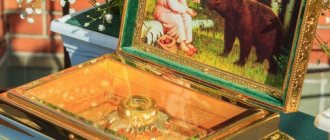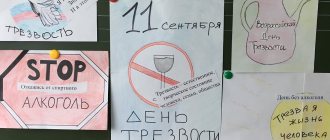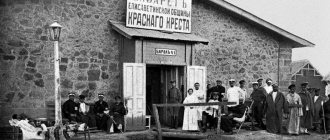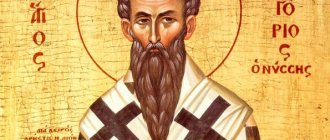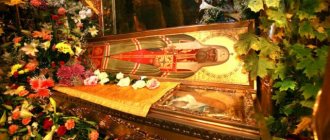Childhood. Youth. Spiritual maturation
In Epiphany - Joachim, belonged to the illustrious Gorlenko family, known throughout Little Russia.
Joachim came from the Poltava province (Pryluki town), born on September 8, 1705.
His father, Andrei Dimitrievich, was a military man and rose to the rank of colonel. Both he himself and his wife, Maria Danilovna, were pious and God-fearing people. Planning the future of their son, the couple wanted him to inherit noble estates and follow in his father's footsteps. But Divine Providence outlined a different path for him.
When Joachim was a child, the Lord revealed His will for the boy through his father. Once, sitting on the porch, he saw the Virgin Mary in the rays of the sunset. The Most Pure Virgin stood in the air, She was accompanied by an angel, and Joachim was at Her feet. He knelt before Her and prayed heartily. Then the Mother of God announced that his prayer had been heard. At that very moment, a Heavenly angel flew down and clothed Joachim in the mantle of a bishop. Stunned by this turn of events, the father suddenly asked the Lady, what does She leave for them, the parents? He did not hear an answer.
Joachim was brought up in the fear of God and Christian love. The time came, and his parents, despite the sadness of the upcoming separation, sent him to study at the Kyiv Academy. Here, with the assistance of God, he was kindled with the desire for monastic life.
By the time he completed his education, in the 16th year of his life, Joachim had already disposed his heart to take monastic vows. However, having returned to his parents and fearing to sadden them with this plan, for the time being he hid his heartfelt attitude.
Icons
During the life of the saint, many portraits were made of him, so his appearance is well known. He had a lean face, dark eyes, and slightly curly hair. There are two types of icons of Joasaph of Belgorod:
- in the festive vestments of a bishop;
- in a bishop's robe.
In both images, in the left hand of the righteous man there is a rod - a symbol of bishop’s power, because in the Holy Scriptures the clergy is often compared to shepherds who are called upon to protect their people, to keep them from spiritual dangers. The right hand can be folded in blessing, or the saint holds a cross in it.
Become a courier of the Yandex.Food service right now (up to 3,400 rubles per shift) leave a request →
There is a rare icon in one of the museums, where the portrait is surrounded by the most famous scenes from the life of the saint. Before official approval, numerous icon portraits were passed around. Most of them do not have a halo, or have other deviations from the rules. After canonization, a special church image was developed and approved by the commission. The icon has a portrait resemblance to the saint, but was painted according to Orthodox canons.
The saint is also depicted among those saints who were glorified at the same time - in the late 19th and early 20th centuries.
Path of the Novice
Some time later, Joachim, citing the need to complete his educational course, left for Kyiv. Then he went to the deserted Transfiguration of the Savior Kiev-Mezhigorsk monastery.
Having entered the monastery, he devoted himself to humble obedience and prayer. Sometimes, when circumstances permitted, he would retire to a cave for contemplation and prayer.
Fearing that his stay at the monastery might be interrupted through parental intervention, Joachim left a servant in Kyiv, and he, receiving messages from home, delivered them to the monastery. As Joachim composed reply letters, the servant sent them home on his behalf.
In 1725, Joachim, having passed the tests required for a novice, accepted the ryassophore with the name Hilarion. After this, he opened up to his parents, fervently asking their forgiveness for his deception and for deciding to take such an important step without their blessing.
Miraculous image
Work as a courier at Yandex.Eda (up to 3,400 rubles per shift) leave a request →
The saint often traveled around his diocese, checking how the service was going on. One day, the Mother of God appeared to him in a dream and complained that her holy image did not receive due veneration. During the next inspection, the saint actually found an old icon, which in one of the churches was used instead of a partition. Today this miraculous image is known as the Peschanskaya Icon of the Mother of God.
Monastic life
Two years later, in 1727, Hilarion the Rassophore was summoned to the Brotherhood of Kyiv. Here he was tonsured into a mantle and received a new name - Joasaph (in memory and honor of the Indian prince Joasaph).
In January 1728, Joasaph was ordained as a hierodeacon and assigned to the Kyiv Academy as a lower-class teacher.
He worked as a teacher for three years, after which the spiritual authorities sent him to collect donations (for the repair of academic buildings) throughout the territory of Little Russia.
In 1734, Hierodeacon Joasaph was appointed to the position of examiner at the Kyiv department.
Soon he was ordained a hieromonk.
In 1737, Archbishop Rafail Zaborovsky appointed Father Joasaph as abbot of the Lubensko-Mgarsky Transfiguration Monastery. He humbly fulfilled the will of the bishop, although due to the same humility he did so reluctantly: he did not consider himself, a sinner, worthy of such a high title.
Another monastery, Krasnogorsk, as well as several local churches came under the leadership of the abbot.
Despite the difficulties associated with leading the brethren and the monastic economy, as well as ill health, Father Joasaph did not weaken the severity of his ascetic deeds.
In September 1744, with the assistance of Empress Elizabeth, he was awarded the title of archimandrite. Soon he was called to Moscow. Here, in January 1745, Father Joasaph received an appointment to the position of abbot of the Holy Trinity St. Sergius Monastery. This obedience lasted until June 1748.
short biography
The saint was born on September 9, 1705 - on the Nativity of the Mother of God. He was named Joachim in honor of the father of the Virgin Mary. It was as if the Mother of God had taken the boy under her protection. Later, She appeared to his father in a vision to inform him of Joachim’s sacred destiny - serving God and people.
Origin
The Gorlenko family, into which the future Bishop of Belgorod was born, is an ancient Little Russian family. His ancestors lived in the Zaporozhye Sich. Relatives who lived on Polish territory, along the Dnieper River, actively supported Orthodoxy and built churches. In the 17th century, the Gorlenko family was ranked among the Russian nobles.
Family
Joachim's father is Andrei Dimitrievich Gorlenko, standard-bearer of Hetman Danila the Apostol. Mother - Maria, daughter of the hetman. Both were religious people, kept fasts, lived by the commandments, and were engaged in charity. The paternal grandfather, Dimitri, built two churches - in honor of Nicholas the Wonderworker and the apostles Peter and Paul.
Education
The parents wanted to transfer the management of the estates and titles to their son. They did not expect that he would want to leave worldly life. At the age of 8, Joachim’s parents sent him to study at the Kyiv Academy, where the boy studied literature.
Choosing a life path and taking tonsure
Raised in Christian traditions, the young man was imbued with a pious and spiritual way of life. Studying in Kyiv contributed to this. The Academy supported Orthodoxy and opposed the Roman Catholic Church. Joachim spent a lot of time with the monks of the Kiev Pechersk Monastery. He decided to take monastic vows, but could not tell his parents about it.
Leaving as if to study, he secretly spent 2 years in the Kiev-Mezhigorsky Spaso-Preobrazhensky Monastery. The young novice secluded himself in a cave, observed strict fasting and prayed. The deception was hidden thanks to a faithful servant. At the age of 21, Joachim became a monk under the name Hilarion. He also conveyed the news of the tonsure and requests for forgiveness to his parents through an assistant. At the age of 22, the monk Hilarion, for his strict asceticism, was tonsured into the mantle in the Kiev Brotherhood Monastery under the name of the Indian prince Joasaph.
Acquiring ordination and appointment as abbot
The Kyiv Archbishop ordained the monk Joasaph to the rank of hierodeacon. Having received the obedience of the teacher, the future saint taught science to students at the Kyiv Academy for three years. The new archbishop, the ascetic Rafail Zborovsky, noticed the spiritual talent of the young hierodeacon and took him under his protection. The Archbishop entrusted Joasaph with collecting donations for the renovation of the Academy buildings, and he traveled all over Little Russia. Having accepted the rank of hieromonk with the blessing of his patron, Joasaph served as a shepherd at the Kiev Fraternal and Kiev St. Sophia Cathedrals, and was also a member of the Kyiv Spiritual Consistory.
The humility and hard work of the hieromonk and shepherd was again appreciated by Archbishop Zborovsky and appointed Joasaph as abbot of the Lubensko-Mgarsky Transfiguration Monastery. The 30-year-old ascetic did not want to accept a difficult position, since he had to manage the Lubensk and Krasnogorsk monasteries and several churches. Extreme humility forced him to agree and fulfill the wide range of duties of the abbot. But his hard work, care and mercy entered the chronicles of the large monastery. The abbot spent a lot of effort on restoring the destroyed buildings, although his health was already undermined.
Belgorod diocese
The tireless servant Joasaph was chosen to replace the deceased Metropolitan of Belgorod from the list of applicants. He began his service as archpastor with the Divine Liturgy, which he served immediately upon his arrival in Belgorod. For the sick and road-weary Joasaph, this was a feat. Overcoming the weakness of the body, humility before God's Will, love for parishioners and diligence marked his work in the Belgorod diocese.
The new metropolitan took up the education of poor peasants and orphans, the spiritual education of the flock and subordinate pastors. Saint Joasaph himself toured the domains entrusted to him.
The archpastor was merciful to the poor. On holidays, he secretly gave money and clothes to needy families by sending a servant. He left gifts at the doors of homes and left unnoticed.
Details of the life of the saint
Interesting facts from the life of St. Joasaph:
- while working at the Lubensky monastery, Patriarch Athanasius of Constantinople appeared to him twice and expressed approval;
- Collecting taxes for the improvement of churches, Abbot Joasaph reached St. Petersburg, where he received the favor of Empress Elizabeth Petrovna and a donation from her of 2,000 rubles.
- at her command, he became archimandrite and rector of the Holy Trinity Sergius Lavra;
- Saint Joasaph led a modest life, ate sparingly, and avoided amusements. During feasts at my parents’ house, I sat separately from the guests and ate bread crusts. Traveling around the Belgorod estates, he stayed in the houses of ordinary peasants, refusing comfortable and rich apartments;
- The Bishop of Belgorod cultivated reverence for shrines and church services in his subordinate clergy. He monitored their spiritual purity and drew up special rules. One of them is the prohibition of holding a service if the priest and the deacon are in a quarrel;
- asceticism and asceticism contributed to the high development of the spirit and vision of Saint Joasaph. With the help of God's revelations, he many times revealed violations of discipline by ministers and their careless handling of the Sacred Gifts and icons;
- Metropolitan of Belgorod defended his pastors from the unfair and willful attitude of the landowners, without fear of their anger or revenge. Thus, he returned the position to the clerk, whom the manager of the princely estate had arbitrarily expelled from the village church. Otherwise, the saint threatened to leave the village without a church. Saint Joasaph never became a hypocrite before titles and nobility;
- Thanks to his highly developed spiritual perception, frequent visions and premonitions, Saint Joasaph became famous as a miracle worker. According to the revelation of the Mother of God, the archpastor found Her icon in the Ascension Church in the city of Izyum. It served as a screen for coal in the vestibule. Nowadays the image is known as the miraculous Peschanskaya Icon of the Mother of God.
In life, Saint Joasaph was easy to communicate with and treated people with warmth. External severity reflected moral purity. The Bishop of Belgorod was not afraid of the opinion of the world, and did not strive to earn its favor. God, duty and truth came first for him.
Illness and death
Before his death, Saint Joasaph went to see his parents in Priluki. Leaving Belgorod, he said goodbye to his flock, blessed everyone and said that he would not return. The meeting with my father was respectful and reverent. On the way back, the archpastor fell ill. He spent two months in the village of Gayvoron, bedridden. Saint Joasaph reposed on December 10, 1754 at the age of 49.
Imperishable relics
The saint's body was sent to Belgorod. For more than two months it was in the Holy Trinity Cathedral in an open coffin without signs of decomposition. Later, the body of Saint Joasaph was placed in a crypt. Even two years later, his relics remained incorrupt.
Honor and glorification
At numerous requests from the laity and clergy, the Holy Synod, with the consent of Nicholas II, canonized Saint Joasaph in 1910. The Synod commission included Prince Zhevakhov, who compiled a monograph in three volumes about the life of the saint and later took monastic vows in his honor.
Episcopal ministry
In 1748, Archimandrite Joasaph was consecrated Bishop of Belgorod and Oboyan.
In August of the same year he arrived at the department in Belgorod. On the day of his arrival, despite fatigue from the long journey and physical illness, he served the Divine Liturgy in the cathedral.
The diocese entrusted to the saint was distinguished by the depressing poverty of its inhabitants. Many children of clergy, and especially orphans, did not have sufficient funds to pay for their content in theological schools. This affected their educational level. Reacting to the situation, the saint, as best he could, provided financial assistance to those in need.
In order to improve the diocese and improve the situation, he personally traveled around the territory, not excluding remote regions. In order to raise the moral level of the population, he visited the homes of his charges, both rich and poor, and taught them lessons in Christian morality.
He made a lot of efforts to raise the spiritual and moral level among the clergy, vigilantly monitoring not only how the divine service was performed, but also the inner disposition with which the shepherds performed the priesthood. One of his demands, for example, obliged priests who were in a quarrel with other priests not to begin worship until they came to reconciliation.
For violation of church charter and personal orders, the saint could subject the disobedient to severe punishment.
So, one day, while surveying the diocese, he stopped at the house of a priest. At night the saint suffered from insomnia and inexplicable fear. Suddenly, looking closely, he discovered that on the shelf, next to the kitchen utensils, in one of the paper wrappers, there were the Holy Gifts. The bishop was horrified by what he saw. Carefully placing the shrine on the table, he prayed all night, asking God to avert the terrible punishment from the priest. The next morning, Saint Joasaph explained to the shepherd what his mistake was, and then deprived him of his rank.
Another time, upon inspiration from above, entering one of the temples, he discovered a drunken cleric and also stripped him of his title.
Due to special zeal and the highest righteousness, Father Joasaph acquired such closeness to the Creator that he was endowed with the gift of clairvoyance from Him.
One day he called the priests to him for a conversation. One of them stood out for its unusually rare age: he was 130 years old. After the conversation, having blessed the invitees, the bishop dismissed them to their own affairs and turned to the elder with the question, what kind of sin binds him, and why can’t he die for so long? The elder, as if he did not know the excessive sin behind him, and considered his longevity to be the result of Divine mercy, was amazed, but under the watchful gaze of the bishop he still understood what kind of sin he was talking about. Once upon a time, when he was still young, such an incident happened to him. He served the Liturgy and was about to leave. But at that moment he was stopped by the landowner's envoy, who demanded that he serve the Liturgy a second time, for the sake of his master. The shepherd tried to explain that this was impossible in principle, since it contradicted the canons, but his explanations were unsuccessful. Then, fearing the wrath of the landowner, he chose to obey. When I began to perform the service (on the same throne), I heard a mysterious voice demanding that I stop. The priest wavered, but the fear of the master turned out to be stronger than the fear of the Lord, and he continued to commit lawlessness. The voice again told the priest not to dare to do evil, so as not to fall under the curse. The priest, in madness, snapped: Be damned yourself!, and continued to sing the liturgy.
Hearing this story, the saint was taken aback and pointed out to the elderly shepherd that he had cursed the Heavenly Messenger, the guardian of the place. Then he ordered the erection of a camp church and the Divine Liturgy to be served at the site of that sacrilege. After this, he absolved the elder from his sins. Having been cleansed by repentance and reconciled with the Lord and the angel, the elder rested. His body was buried there, and the saint personally participated in his funeral service.
Glorification among the saints
In 1911, the Bishop of Belgorod was glorified. And in 1912, a temple in the name of the saint appeared in the village of Pargolovo. It was built at his own expense, on his own land, by the peasant Konstantin Timofeevich Ryzhov. This suggests that Joasaph of Belgorod was revered by the people long before his official glorification.
After the death of the saint, in the place where during his life there was a bishop's house and a church in honor of the Transfiguration of the Lord, a chapel was erected. Subsequently, under Soviet rule, it was destroyed. It has already been restored in our time. On September 16, 1997, the foundation stone was consecrated, and on December 20, 1998, the consecration of the newly built chapel took place.
On a note! Next to the chapel church, a spiritual and educational center was built in the name of the holy Bishop of Belgorod.
Last days of earthly life
Shortly before his death, Saint Joasaph wished to meet his parents. Having asked permission from the Synod, he said goodbye to his flock in a Christian manner and left for Priluki.
Coming out to meet his beloved son, the father experienced confusion. As a Christian, he had to bow to the bishop, but as a father he himself could count on bowing. When the son got out of the carriage, the father, as if by accident, dropped his cane. As soon as he bent down to pick it up and at the same time bow, the son understood his plan, bowed to his parent and handed him the fallen cane. Then they hugged.
After staying in his father's house, Saint Joasaph went to Belgorod. It was September 1754. Along the way, in the village of Grayvoron, he fell ill and died two months later. Just before his death, he confessed his sins and partook of the Body and Blood of Christ. Death occurred on December 10, 1754.
Prayer 1
O Saint Joasaph of Christ, wonderworker of Belograd! We believe in sins and unworthiness, as the eyes of the Lord are on the righteous and His ears are on their prayer, and for this sake we resort to your prayers and ask your intercession for us, according to the apostolic verb, with hope, as if your love will no longer disappear. In our sins and illnesses we have become like smoking flax and a broken reed, and while we live, we live by the grace of God and through the prayers of His righteous One. Therefore, you, righteous father, incline your heart to our prayer, and through your intercession give peace and blessing to the Christian family from the Lord. Strengthen Orthodoxy, and drive away the attacks of the evil and lawless on the Church of God. Pray to the Heavenly Father to deliver us from the enemy invasion, from civil strife and national turmoil, from destructive epidemics and deadly plagues, from famine, fire, flood and other troubles and circumstances. Ask Christ God for strength for our souls and the health we need for our bodies, and healing for sickness: walking for the lame, sight for the blind, strengthening for the weakened, consolation for the sad, and deliverance from all sorrows. But unite the fallen vines of Christ again with you, even as you yourself were deemed worthy to be a partaker, so that by you the most honorable and magnificent Name of Our God, the Father and the Son and the Holy Spirit, may be glorified, now and ever and unto the ages of ages. Amen.
Prayer 2, spoken before the holy relics of the saint
O great servant of God and glorious miracle worker, Saint Joasaph! From distant and near cities and villages, having come together to pray in the place of your deeds and kiss your many-healing relics, from the depths of our hearts we cry to you: with a rod of goodness, like a good shepherd, protect the lost sheep of the flock of Christ, into these courts of the Lord, protect us from temptation, heresies and schisms, teach us to be wise in our heavenly wanderings: enlighten our scattered mind and direct it to the path of truth, warm our cold heart with love for our neighbor and zeal for fulfilling the commandments of God, revive our weakened will by sin and negligence with the grace of the All-Holy Spirit: and yes Following your pastoral voice, let us preserve our souls in purity and truth, and thus, helping God, we will achieve the Heavenly Kingdom, where together with you we will glorify the Most Honorable and Magnificent Name of the Father and the Son and the Holy Spirit forever and ever. Amen.
Temples in the name of the saint
The main temple of Joasaph of Belgorod is located at the place of his ministry, this is the cathedral of Belgorod. The remains of the saint rest there. Every year a religious procession is held with the relics through the streets of the city. The Transfiguration Church was built at the beginning of the 19th century. This is a two-story building with a high bell tower, in which there were 5 thrones. In the 60s, the building housed a museum. When the relics of the saint were returned in the 90s, the cathedral was returned to the Church.
- Apostle James
- Saint Alexander of Svirsky - see here
- Agapit Pechersky -
